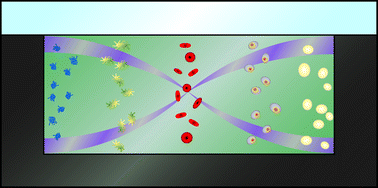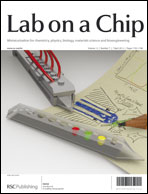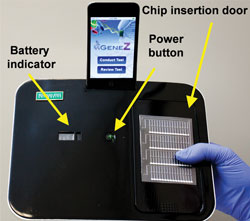
If you’ve missed any of the previous articles take a look at the web collection here.

If you’ve missed any of the previous articles take a look at the web collection here.
View the new videos on the Lab on a Chip YouTube site below:
Concentration landscape generators for shear free dynamic chemical stimulation
.
Microfluidic platform for combinatorial synthesis in picolitre droplets
.
Pulsed laser triggered high speed microfluidic fluorescence activated cell sorter
.
.
Experimental validation of plugging during drop formation in a T-junction

A multifunctional pipette
Alar Ainla, Gavin D. M. Jeffries, Ralf Brune, Owe Orwar and Aldo Jesorka
DOI: 10.1039/C2LC20906C

Engineers are from PDMS-land, Biologists are from Polystyrenia
Erwin Berthier, Edmond W. K. Young and David Beebe
DOI: 10.1039/C2LC20982A
Another HOT article in this issue is by Serge G. Lemay and colleagues at the MESA+ Institute for Nanotechnology, University of Twente, reporting on their study of the response time of nanofluidic thin-layer cells as electrochemical sensors, and suggested means of improving that time.
Response time of nanofluidic electrochemical sensors
Shuo Kang, Klaus Mathwig and Serge G. Lemay
DOI: 10.1039/C2LC21104A
This issue also features the latest article in our Acoustofluidics series, by Thomas Laurell and colleagues at Lund University, Applications of acoustophoresis in continuous flow microsystems; and our latest Research Highlights from Ali Khademhosseini and colleagues.
As usual, all our HOT articles are free to access for four weeks (following a simple registration for individual users).
US scientists have developed a device dubbed Gene-Z for point-of-care genetic testing using a smartphone interface that has realistic commercial potential.
The device, made by Robert Stedtfeld at Michigan State University and colleagues, is cheap, with an estimated manufacture cost of less than $350. It’s small, about the size of a tablet computer, and weighs less than a bag of sugar. And, you can operate it via an app on a smartphone.

The Gene-Z device
The team’s prototype consists of a disposable plastic chip with four arrays containing the dried primers required for a genetic assay, allowing parallel processing of four samples with multiple genetic markers for accurate disease diagnosis. The chip sits in an aluminium heater bed, through which LEDs are fed for real-time optical detection, and the whole thing is encased in sleek black packaging with a dock for an iPod Touch or iPhone.
Holger Becker, co-founder of microfluidic ChipShop, Germany, is impressed. ‘I like it for a couple of reasons,’ he says, ‘it’s not over-engineered, it addresses a couple of very typical problems in a point-of-care diagnostic device and there is a simplicity in the approach, especially in the detection system.’
The team made two major changes to existing designs, explains team member Syed Hashsham. First, they made the disposable microfluidic chip from polyester, rather than the more traditional silicon or polydimethylsiloxane. Hashsham says he was inspired by ‘kitchen chemistry’. If plastic food bags can be sealed to keep your sandwiches fresh, he reasoned, then plastic membranes in the chip would stop samples escaping during loading. This avoids the need for mechanical valves and the plastic chips are easy to design and fabricate. You can think one up in the morning and use it in the afternoon, he says, whereas silicon chips take weeks to develop.
Second, the team rejected polymerase chain reactions (PCR) in favour of the loop-mediated isothermal amplification (LAMP) assay. The LAMP assay requires no thermal cycling, requires cheaper optics for detection and is robust – as opposed to PCR, which Hashsham describes as ‘finicky’. Finally, they used WiFi and a smartphone with a custom-built app as the interface to manage data from the device.
Using WiFi does throw up a couple of problems, however: the safe transmission of potentially sensitive patient data via a wireless network, use in hospital settings where signals can interfere with other equipment and viability in areas without an internet connection. Stedtfeld and his team are working with other groups to address the encryption and interference issues. They say that their next step is to make the Gene-Z device compatible with an ordinary mobile phone, so that information can be transmitted via SMS and, by adding solar cells, the device could be used in rural settings.
Gene-Z: a device for point of care genetic testing using a smartphone
Robert D. Stedtfeld, Dieter M. Tourlousse, Gregoire Seyrig, Tiffany M. Stedtfeld, Maggie Kronlein, Scott Price, Farhan Ahmad, Erdogan Gulari, James M. Tiedje and Syed A. Hashsham
DOI: 10.1039/C2LC21226A
Read the original article at Chemistry World
This month sees the following articles in Lab on a Chip that are in the top ten most accessed:
Antigen-responsive, microfluidic valves for single use diagnostics
Brad J. Berron, Allison M. May, Zheng Zheng, Vivek Balasubramaniam and Christopher N. Bowman
Lab Chip, 2012, 12, 708-710
DOI: 10.1039/C2LC21101G
High throughput production of single core double emulsions in a parallelized microfluidic device
Mark B. Romanowsky, Adam R. Abate, Assaf Rotem, Christian Holtze and David A. Weitz
Lab Chip, 2012, 12, 802-807
DOI: 10.1039/C2LC21033A
Young researchers to tackle future Grand Challenges
Anna Sjöström Douagi and Helene Andersson Svahn
Lab Chip, 2012, 12, 680-683
DOI: 10.1039/C1LC90138A
Education: a microfluidic platform for university-level analytical chemistry laboratories
Jesse Greener, Ethan Tumarkin, Michael Debono, Andrew P. Dicks and Eugenia Kumacheva
Lab Chip, 2012, 12, 696-701
DOI: 10.1039/C2LC20951A
Rapid prototyping of three-dimensional microfluidic mixers in glass by femtosecond laser direct writing
Yang Liao, Jiangxin Song, En Li, Yong Luo , Yinglong Shen, Danping Chen, Ya Cheng, Zhizhan Xu, Koji Sugioka and Katsumi Midorikawa
Lab Chip, 2012, 12, 746-749
DOI: 10.1039/C2LC21015K
Continuous separation of microparticles in a microfluidic channel via the elasto-inertial effect of non-Newtonian fluid
Jeonghun Nam, Hyunjung Lim, Dookon Kim, Hyunwook Jung and Sehyun Shin
Lab Chip, 2012, Advance Article
DOI: 10.1039/C2LC21304D
Sorting cells by size, shape and deformability
Jason P. Beech, Stefan H. Holm, Karl Adolfsson and Jonas O. Tegenfeldt
Lab Chip, 2012, 12, 1048-1051
DOI: 10.1039/C2LC21083E
Polyurethane-based microfluidic devices for blood contacting applications
Wen-I Wu, Kyla N. Sask, John L. Brash and P. Ravi Selvaganapathy
Lab Chip, 2012, 12, 960-970
DOI: 10.1039/C2LC21075D
Design of pressure-driven microfluidic networks using electric circuit analogy
Kwang W. Oh, Kangsun Lee, Byungwook Ahn and Edward P. Furlani
Lab Chip, 2012, 12, 515-545
DOI: 10.1039/C2LC20799K
Surfactants in droplet-based microfluidics
Jean-Christophe Baret
Lab Chip, 2012, 12, 422-433
DOI: 10.1039/C1LC20582J
Why not take a look at the articles today and blog your thoughts and comments below.
Fancy submitting an article to Lab on a Chip? Then why not submit to us today or alternatively email us your suggestions.